Hyperspectral Inversion of Soil Carbon and Nutrient Contents in the Yellow River Delta Wetland
Abstract
1. Introduction
2. Materials and Methods
2.1. Study Area
2.2. Data Collection
2.3. Data Set Division
2.4. Pre-Processing Methods
2.5. Model Establishment and Verification
3. Results
3.1. Characterization of Carbon, Nitrogen, and Phosphorus Contents of Soils in the Yellow River Delta
3.2. Spectral Data of the Two Wetland Plant Soils
3.3. Correlation Analysis
3.4. Mixed Species Modelling Effects
3.5. Effect of Sample Set Division and Sensitive Band on Modelling
3.5.1. Random Forest Regression Models
3.5.2. Partial Least-Squares Regression Models
3.5.3. Support Vector Machine Regression Models
3.6. Accuracy of the Prediction Models
4. Discussion
4.1. Soil Nutrient Differences
4.2. Differences in the Element Contents Retrieved from the Hyperspectral Data
4.3. Preprocessing Transformations
4.4. Differences in the Prediction Accuracy of the Different Models
5. Conclusions
- (1)
- There was a significant difference in soil total carbon and phosphorus contents between the two vegetation types, and no significant difference in soil carbon, nitrogen, and phosphorus contents between the different strata under the same vegetation type was observed. Therefore, the influence of vegetation type should be considered prior to making modelling predictions.
- (2)
- The trends of soil correlation coefficient curves were similar for different vegetation types, while the maximum correlation coefficients differed. The first derivative reflectance had a large increase in correlation coefficients compared with the correlation coefficients between the original spectral reflectance and soil carbon, nitrogen, and phosphorus contents.
- (3)
- The first derivative treatment and division of sample sets according to vegetation types improved the modelling accuracy. The best prediction method for the TC, TN, and TP contents of the P. australis soils was to divide the sample set plus FD plus RF, while that of the S. salsa soils was to divide the sample set plus FD plus SVM.
Author Contributions
Funding
Institutional Review Board Statement
Data Availability Statement
Conflicts of Interest
References
- Bartholomeus, H.; Kooistra, L.; Stevens, A.; van Leeuwen, M.; van Wesemael, B.; Ben-Dor, E.; Tychon, B. Soil Organic Carbon mapping of partially vegetated agricultural fields with imaging spectroscopy. Int. J. Appl. Earth Obs. Geoinf. 2011, 13, 81–88. [Google Scholar] [CrossRef]
- Rahman, M.M.; Kamal, M.Z.U.; Ranamukhaarachchi, S.; Alam, M.S.; Alam, M.K.; Khan, M.A.R.; Islam, M.M.; Alam, M.A.; Jiban, S.I.; Al Mamun, M.A.; et al. Effects of Organic Amendments on Soil Aggregate Stability, Carbon Sequestration, and Energy Use Efficiency in Wetland Paddy Cultivation. Sustainability 2022, 14, 4475. [Google Scholar] [CrossRef]
- Ledford, K.; Schmidt, S.A.; Ahn, C. Assessing carbon storage potential of forested wetland soils in two physiographic provinces of northern virginia, USA. Sustainability 2022, 14, 2048. [Google Scholar] [CrossRef]
- Reich, P.B.; Tjoelker, M.G.; Machado, J.; Oleksyn, J. Universal scaling of respiratory metabolism, size and nitrogen in plants. Nature 2006, 439, 7075. [Google Scholar] [CrossRef] [PubMed]
- Lu, M.; Liu, K.; Zhang, L.; Zeng, F.; Song, T.; Peng, W.; Du, H. Stoichiometric Variation in Soil Carbon, Nitrogen, and Phosphorus Following Cropland Conversion to Forest in Southwest China. Forests 2022, 13, 1155. [Google Scholar] [CrossRef]
- Spohn, M.; Stendahl, J. Carbon, nitrogen, and phosphorus stoichiometry of organic matter in Swedish forest soils and its relationship with climate, tree species, and soil texture. Biogeosciences 2022, 19, 2171–2186. [Google Scholar] [CrossRef]
- Wang, X.W.; Sun, X.X.; Sun, L.; Chen, N.; Du, Y. Small-Scale Variability of Soil Quality in Permafrost Peatland of the Great Hing’an Mountains, Northeast China. Water 2022, 14, 2597. [Google Scholar] [CrossRef]
- Serrani, D.; Cocco, S.; Cardelli, V.; D′Ottavio, P.; Borguete, A.R.R.; Feniasse, D.; Vilanculos, A.; Fernández-Marcos, M.L.; Giosué, C.; Tittarelli, F.; et al. Soil fertility in slash and burn agricultural systems in central Mozambique. J. Environ. Manag. 2022, 322, 116031. [Google Scholar] [CrossRef]
- Tedontsah, V.P.L.; Mbog, M.B.; Ngon, G.F.N.; Edzoa, R.C.; Tassongwa, B.; Bitom, D.; Etame, J. Physicochemical Properties and Fertility Assessment of Soils in Foumban (West Cameroon). Appl. Environ. Soil Sci. 2022, 2022, 7889430. [Google Scholar] [CrossRef]
- Chen, M.Y.; Yang, X.; Shao, M.A.; Wei, X.R.; Li, T.C. Changes in soil C-N-P stoichiometry after 20 years of typical artificial vegetation restoration in semiarid continental climate zones. Sci. Total Environ. 2022, 852, 158380. [Google Scholar] [CrossRef]
- Sweetman, A.J.; Valle, M.D.; Prevedouros, K.; Jones, K.C. The role of soil organic carbon in the global cycling of persistent organic pollutants (POPs): Interpreting and modelling field data. Chemosphere 2005, 60, 959–972. [Google Scholar] [CrossRef] [PubMed]
- Amol, D.V.; Karbhari, V.K.; Sandeep, V.G. Estimation of soil nitrogen in agricultural regions by VNIR reflectance spectroscopy. SN Appl. Sci. 2020, 2, 21–56. [Google Scholar]
- Zheng, W.; Lu, X.; Li, Y. Hyperspectral identification of chlorophyll fluorescence parameters of Suaeda salsa in coastal wetlands. Remote Sens. 2021, 13, 2066. [Google Scholar] [CrossRef]
- Lin, C.; Hu, Y.; Liu, Z.; Peng, Y.; Wang, L.; Peng, D. Estimation of cultivated land quality based on soil hyperspectral data. Agriculture 2022, 12, 93–98. [Google Scholar] [CrossRef]
- Dhawale, N.M.; Adamchuk, V.I.; Prasher, S.O.; Rossel, R.A.V.; Ismail, A.A. Evaluation of two portable hyperspectral-sensor-based instruments to predict key soil properties in canadian soils. Sensors 2022, 22, 2556. [Google Scholar] [CrossRef] [PubMed]
- Yu, S.y.; Bu, H.R.; Dong, W.C.; Jiang, Z.; Zhang, L.X.; Xia, Y.Q. Construction and Evaluation of Prediction Model of Main Soil Nutrients Based on Spectral Information. Appl. Sci. 2022, 12, 6298. [Google Scholar] [CrossRef]
- Odebiri, O.; Mutanga, O.; Odindi, J.; Naicker, R.; Masemola, C.; Sibanda, M. Deep learning approaches in remote sensing of soil organic carbon: A review of utility, challenges, and prospects. Environ. Monit. Assess. 2021, 193, 802. [Google Scholar] [CrossRef]
- Misbah, K.; Laamrani, A.; Khechba, K.; Dhiba, D.; Chehbouni, A. Multi-Sensors remote sensing applications for assessing, monitoring, and mapping npk content in soil and crops in african agricultural land. Remote Sens. 2021, 14, 81. [Google Scholar] [CrossRef]
- Chandan, G.; Naorem, J.S.; Bijoy, K.H. Hyperspectral spectroscopic study of soil properties a review. Int. J. Plant Soil Sci. 2020, 23, 14–25. [Google Scholar]
- Ewing, J.; Oommen, T.; Jayakumar, P.; Alger, R. Utilizing hyperspectral remote sensing for soil gradation. Remote Sens. 2020, 12, 3312. [Google Scholar] [CrossRef]
- Mônica, S.C.; Marcos, R.N.; Marcelo, L.C.; Renato, H.F.; Everson, C.; Roney, B.D.O. Hyperspectral remote detection as an alternative to correlate data of soil constituents. Remote Sens. Appl. Soc. Environ. 2019, 16, 100270. [Google Scholar]
- Michael, V.; Marie, L.; Sören, T.; Bernard, L. Quantification of soil properties with hyperspectral data: Selecting spectral variables with different methods to improve accuracies and analyze prediction mechanisms. Remote Sens. 2017, 9, 1103. [Google Scholar]
- Xu, S.X.; Wang, M.Y.; Shi, X.Z.; Yu, Q.B.; Zhang, Z.Q. Integrating hyperspectral imaging with machine learning techniques for the high-resolution mapping of soil nitrogen fractions in soil profiles. Sci. Total Environ. 2021, 754, 142135. [Google Scholar] [CrossRef] [PubMed]
- Dhawale, N.M.; Adamchuk, V.I.; Prasher, S.O.; Rossel, R.A.V. Evaluating the Precision and Accuracy of Proximal Soil vis–NIR Sensors for Estimating Soil Organic Matter and Texture. Soil Syst. 2021, 5, 48. [Google Scholar] [CrossRef]
- Guo, H.L.; Zhang, R.R.; Dai, W.H.; Zhou, X.W.; Zhang, D.J.; Yang, Y.H.; Cui, J. Mapping Soil Organic Matter Content Based on Feature Band Selection with ZY1-02D Hyperspectral Satellite Data in the Agricultural Region. Agronomy 2022, 12, 2111. [Google Scholar] [CrossRef]
- Zhu, J.J.; Jin, X.; Li, S.W.; Han, Y.L.; Zheng, W.R. Prediction of Soil Available Boron Content in Visible-Near-Infrared Hyperspectral Based on Different Preprocessing Transformations and Characteristic Wavelengths Modeling. Comput. Intell. Neurosci. 2022, 2022, 9748257. [Google Scholar] [CrossRef]
- Tang, R.N.; Li, X.W.; Li, C.; Jiang, K.X.; Hu, W.F.; Wu, J.J. Estimation of Total Nitrogen Content in Rubber Plantation Soil Based on Hyperspectral and Fractional Order Derivative. Electronics 2022, 11, 1956. [Google Scholar] [CrossRef]
- Zhang, Z.H.; Guo, F.; Xu, Z.; Yang, X.Y.; Wu, K.Z. On retrieving the chromium and zinc concentrations in the arable soil by the hyperspectral reflectance based on the deep forest. Ecol. Indic. 2022, 144, 109440. [Google Scholar] [CrossRef]
- Naveen, J.P.A.; Amr, H.A.; David, B.L.; Nicole, A.H. Modeling soil parameters using hyperspectral image reflectance in subtropical coastal wetlands. Int. J. Appl. Earth Obs. Geoinf. 2014, 33, 47–56. [Google Scholar]
- Zhang, S.; Lu, X.; Zhang, Y.; Nie, G.; Li, Y. Estimation of soil organic matter, total nitrogen and total carbon in sustainable coastal wetlands. Sustainability 2019, 11, 667. [Google Scholar] [CrossRef]
- Zhao, D.M.; Wang, J.Z.; Miao, J.; Zhen, J.N.; Wang, J.J.; Gao, C.J.; Jiang, J.C.; Wu, G.F. Spectral features of Fe and organic carbon in estimating low and moderate concentration of heavy metals in mangrove sediments across different regions and habitat types. Geoderma 2022, 426, 116093. [Google Scholar] [CrossRef]
- Chen, Z.Y.; Ren, S.J.; Qin, R.M.; Nie, P.C. Rapid Detection of Different Types of Soil Nitrogen Using Near-Infrared Hyperspectral Imaging. Molecules 2022, 27, 2017. [Google Scholar] [CrossRef] [PubMed]
- Wei, D.; Zheng, G. Estimation of soil total phosphorus content in coastal areas based on hyperspectral reflectance. Spectrosc. Spectr. Anal. 2022, 42, 158–163. [Google Scholar]
- Gao, Y.; Liu, L.; Zhu, P.; Yang, S.; Guo, W.; Yu, X. Patterns and dynamics of the soil microbial community with gradual vegetation succession in The Yellow River Delta, China. Wetlands 2021, 41, 9. [Google Scholar] [CrossRef]
- Li, F.; Xie, Y.; Chen, X.; Hou, Z.; Li, X.; Deng, Z.; Liu, Y.; Hu, J.; Liu, N. Succession of aquatic macrophytes in the Modern Yellow River Delta after 150 years of alluviation. Wetl. Ecol. Manag. 2013, 21, 219–228. [Google Scholar] [CrossRef]
- Liu, Q.; Liu, G.; Huang, C.; Li, H. Soil physicochemical properties associated with quasi-circular vegetation patches in the Yellow River Delta, China. Geoderma 2019, 337, 202–214. [Google Scholar] [CrossRef]
- Li, G.; Ma, S.; Li, K.; Zhou, M.; Lin, L. Heterogeneity classification based on hyperspectral transmission imaging and multivariate data analysis. Infrared Phys. Technol. 2022, 123, 104180. [Google Scholar] [CrossRef]
- Chen, Y.; Wang, J.; Liu, G. Hyperspectral estimation model of forest soil organic matter in northwest Yunnan Province, China. Forests 2019, 10, 217–233. [Google Scholar] [CrossRef]
- Nikolaos, T.; Nikolaos, T.; Yaron, O.; Eleni, K.; Eyal, B.; John, T.; George, Z. An integrated methodology using open soil spectral libraries and Earth Observation data for soil organic carbon estimations in support of soil-related SDGs. Remote Sens. Environ. 2020, 244, 111793. [Google Scholar]
- Wang, J.J.; Xu, Y.; Wu, G.F. The integration of species information and soil properties for hyperspectral estimation of leaf biochemical parameters in mangrove forest. Ecol. Indic. 2020, 115, 106467. [Google Scholar] [CrossRef]
- Cui, L.; Dou, Z.; Liu, Z.; Zuo, X.; Lei, Y.; Li, J.; Zhao, X.; Zhai, X.; Pan, X.; Li, W. Hyperspectral inversion of phragmites australis carbon, nitrogen, and phosphorus stoichiometry using three models. Remote Sens. 2020, 12, 1998. [Google Scholar] [CrossRef]
- Lin, Y.; Li, Z.; Lv, S.; Huang, H.; Hu, J. Detection of soil total nitrogen, phosphorus and potassium content based on the spectral information of citrus canopy. Am. J. Biochem. Biotechnol. 2020, 16, 177–183. [Google Scholar]
- Sun, W.; Shuo, L.; Xia, Z.; Yao, L. Estimation of soil organic matter content using selected spectral subset of hyperspectral data. Geoderma 2022, 409, 115653. [Google Scholar] [CrossRef]
- Danesh, M.; Bahrami, H.A. Modeling of Soil Sand Particles Using Spectroscopy Technology. Commun. Soil Sci. Plant Anal. 2022, 53, 2216–2228. [Google Scholar] [CrossRef]
- Divyesh, M.V.; Ajay, K.M.; Onkar, D. Development of Spectral Indexes in Hyperspectral Imagery for Land Cover Assessment. IETE Tech. Rev. 2019, 36, 216–230. [Google Scholar]
- Andrea, C.; Frédéric, A.; Francesca, G.; Gilles, G.; Sébastien, L.; Leandro, C.; Sandro, M. Improved estimation of soil clay content by the fusion of remote hyperspectral and proximal geophysical sensing. J. Appl. Geophys. 2015, 116, 135–145. [Google Scholar]
- Nikolaos, T.; Nikolaos, T.; Eyal, B.; John, T.; George, Z. Employing a Multi-Input Deep Convolutional Neural Network to Derive Soil Clay Content from a Synergy of Multi-Temporal Optical and Radar Imagery Data. Remote Sens. 2020, 12, 1389. [Google Scholar]
- Michael, S.K.; David, S.; Kevin, T.; Court, S. The Effects of tidal inundation on the reflectance characteristics of coastal marsh vegetation. J. Coast. Res. 2009, 25, 1177–1186. [Google Scholar]
- Ribeiro, S.G.; Teixeira, A.D.S.; de Oliveira, M.R.R.; Costa, M.C.G.; Araújo, I.C.D.S.; Moreira, L.C.J.; Lopes, F.B. Soil Organic Carbon Content Prediction Using Soil-Reflected Spectra: A Comparison of Two Regression Methods. Remote Sens. 2021, 13, 4752. [Google Scholar] [CrossRef]
- Gao, L.L.; Zhu, X.C.; Han, Z.Y.; Wang, L.; Zhao, G.X.; Jiang, Y.M. Spectroscopy-Based Soil Organic Matter Estimation in Brown Forest Soil Areas of the Shandong Peninsula, China. Pedosphere 2019, 29, 810–818. [Google Scholar] [CrossRef]
- Xu, X.; Chen, S.; Xu, Z.; Yu, Y.; Zhang, S.; Dai, R. Exploring appropriate preprocessing techniques for hyperspectral soil organic matter content estimation in black soil area. Remote Sens. 2020, 12, 3765. [Google Scholar] [CrossRef]
- Wang, S.; Guan, K.Y.; Zhang, C.H.; Lee, D.; Margenot, A.J.; Ge, Y.F.; Peng, J.; Zhou, W.; Zhou, Q.; Huang, Y.Z. Using soil library hyperspectral reflectance and machine learning to predict soil organic carbon: Assessing potential of airborne and spaceborne optical soil sensing. Remote Sens. Environ. 2022, 271, 112914. [Google Scholar] [CrossRef]
- Mondal, B.P.; Sekhon, B.S.; Sahoo, R.N.; Paul, P. Vis-nir reflectance spectroscopy for assessment of soil organic carbon in a rice-wheat field of ludhiana district of punjab. ISPRS-Int. Arch. Photogramm. Remote Sens. Spat. Inf. Sci. 2019, 43, 417–422. [Google Scholar] [CrossRef]
- Anna, P.; Marcin, C.; Jakub, R.; Tadeusz, U. Application of FT-NIR spectroscopy and NIR hyperspectral imaging to predict nitrogen and organic carbon contents in mine soils. Measurement 2020, 164, 108117. [Google Scholar]
- Lin, L.X.; Liu, X.X. Mixture-based weight learning improves the random forest method for hyperspectral estimation of soil total nitrogen. Comput. Electron. Agric. 2022, 192, 106634. [Google Scholar] [CrossRef]
- Pechanec, V.; Mráz, A.; Rozkošný, L.; Vyvlečka, P. Usage of airborne hyperspectral imaging data for identifying spatial variability of soil nitrogen content. ISPRS Int. J. Geo-Inf. 2021, 10, 355. [Google Scholar] [CrossRef]
- Li, H.Y.; Jia, S.Y.; Le, Z.C. Quantitative analysis of soil total nitrogen using hyperspectral imaging technology with extreme learning machine. Sensors 2019, 19, 4355. [Google Scholar] [CrossRef]
- Malmir, M.; Tahmasbian, I.; Xu, Z.H.; Farrar, M.B.; Bai, S.H. Prediction of soil macro- and micro-elements in sieved and ground air-dried soils using laboratory-based hyperspectral imaging technique. Geoderma 2019, 340, 70–80. [Google Scholar] [CrossRef]
- Lu, P.; Wang, L.; Niu, Z.; Li, L.H.; Zhang, W.H. Prediction of soil properties using laboratory VIS–NIR spectroscopy and Hyperion imagery. J. Geochem. Explor. 2013, 132, 26–33. [Google Scholar] [CrossRef]
- Li, W.; Dou, Z.; Cui, L.; Wang, R.; Zhao, Z.; Cui, S.; Zhai, X. Suitability of hyperspectral data for monitoring nitrogen and phophorus content in constructed wetlands. Remote Sens. Lett. 2020, 11, 495–504. [Google Scholar] [CrossRef]
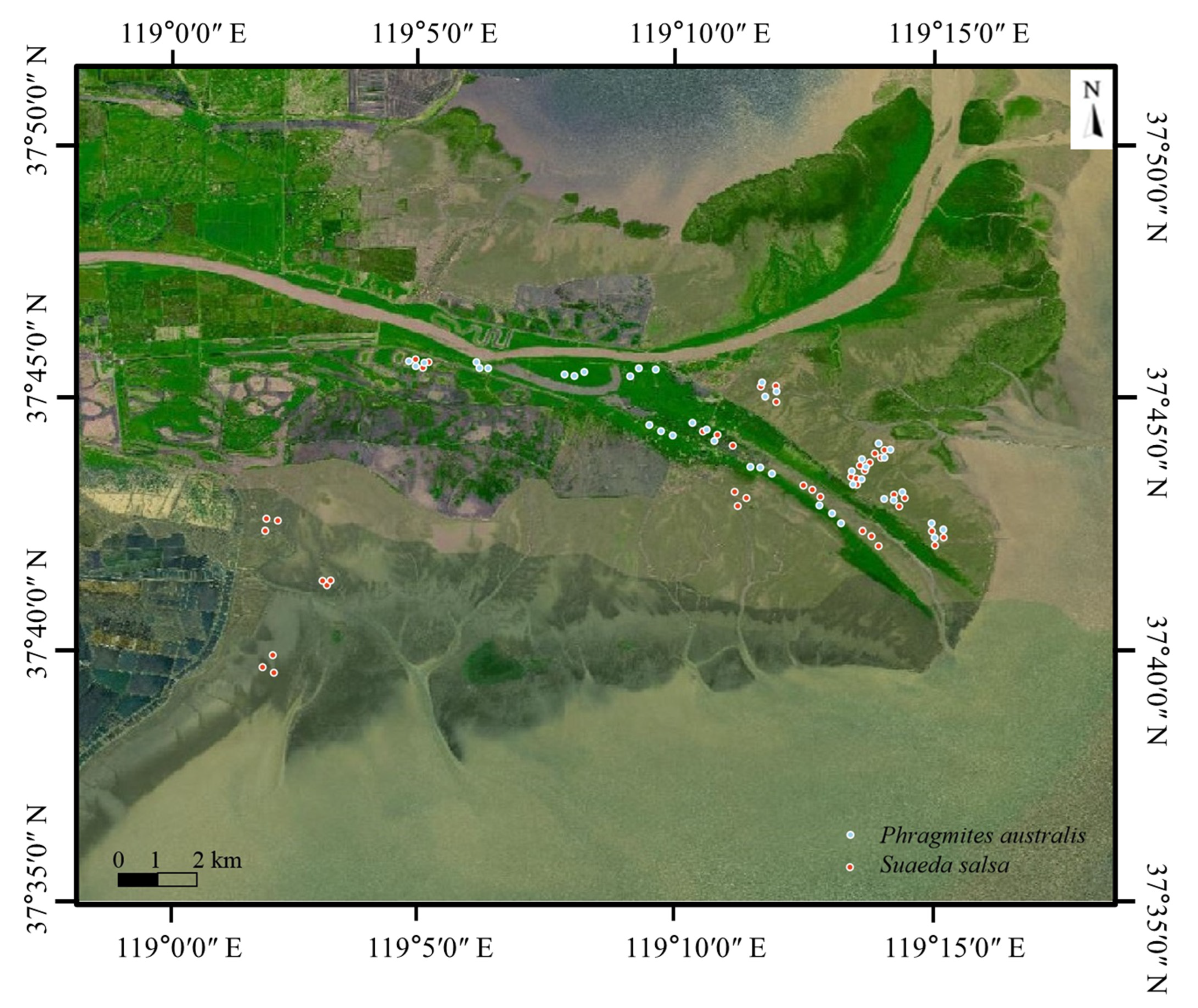
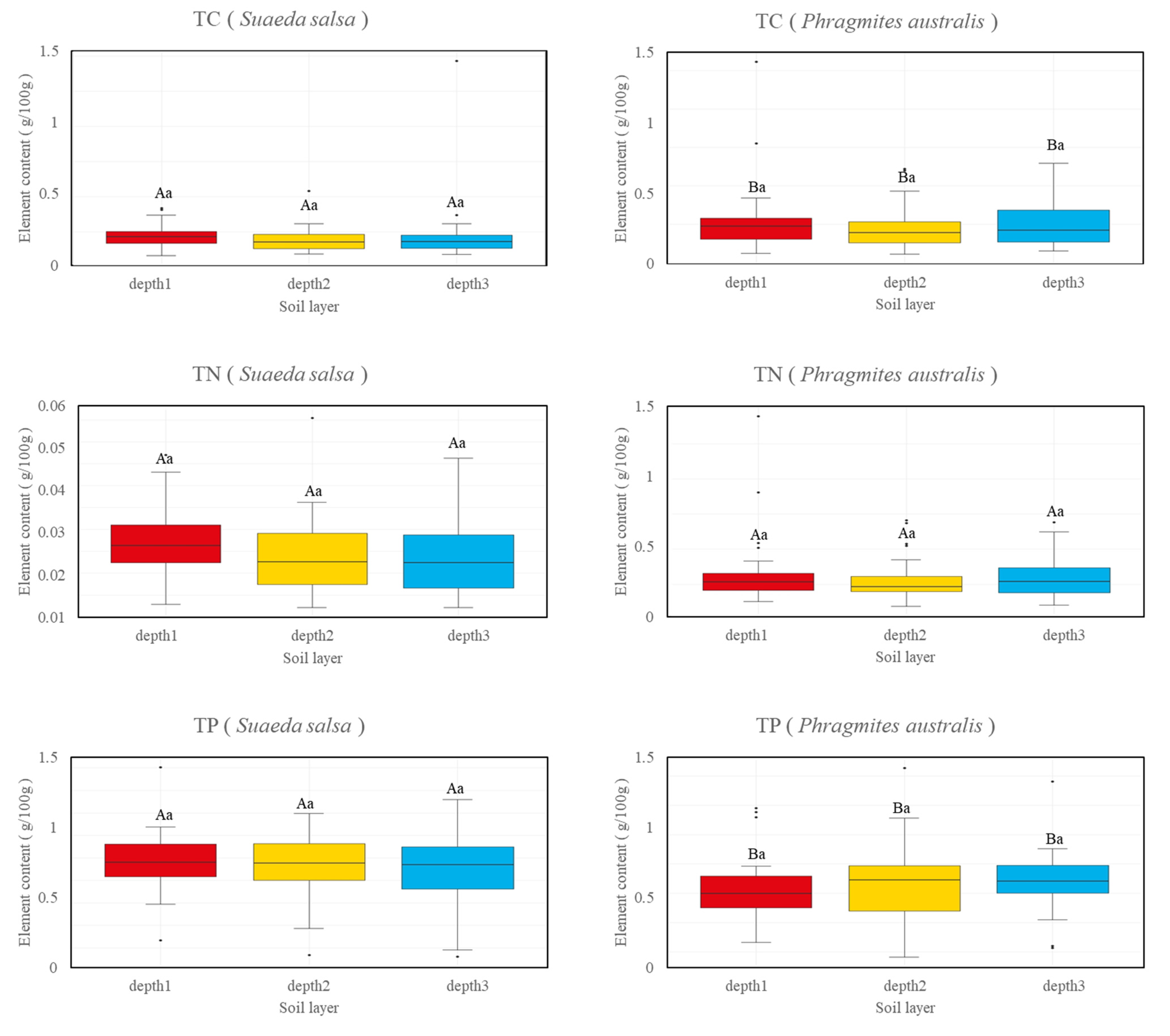
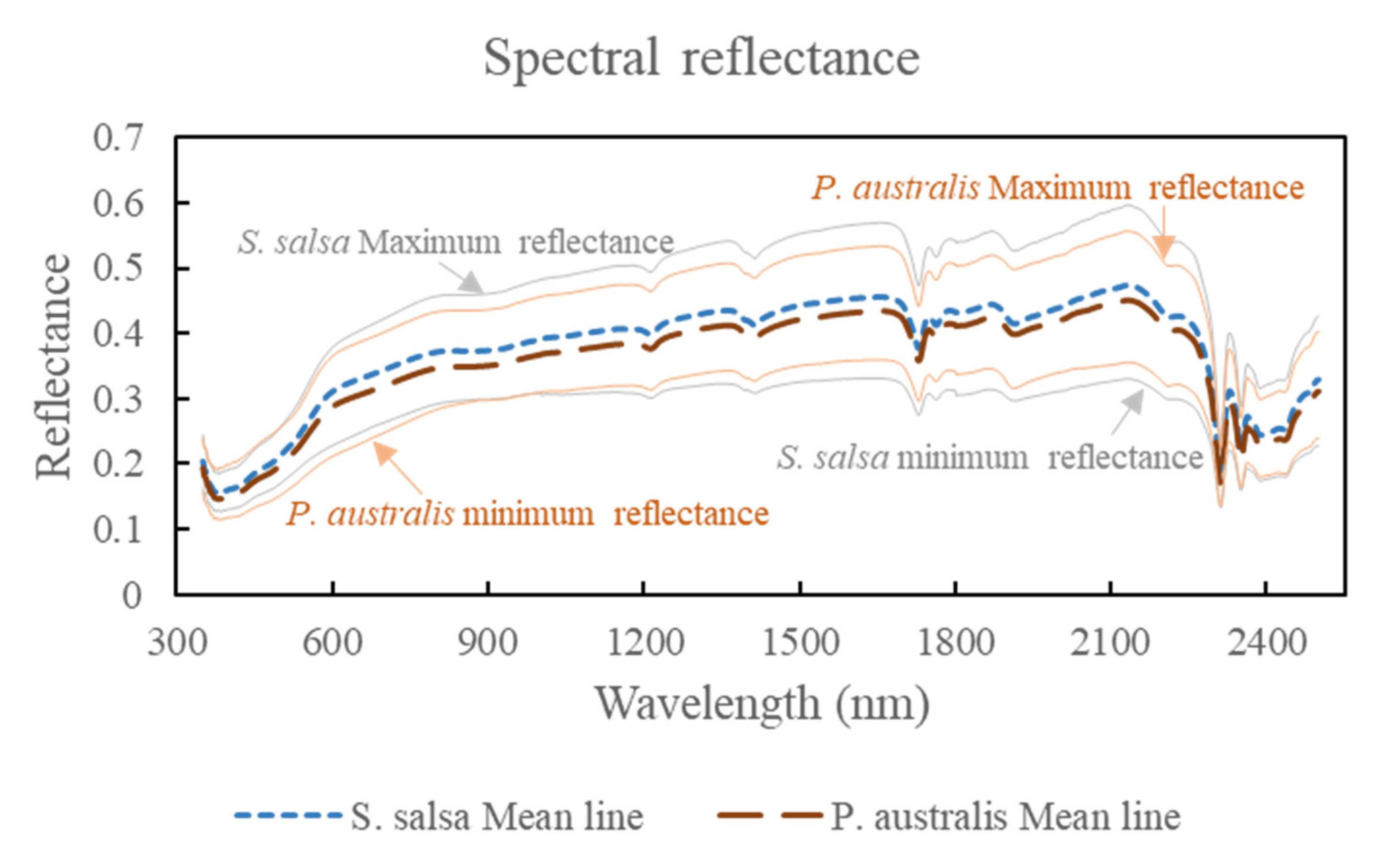
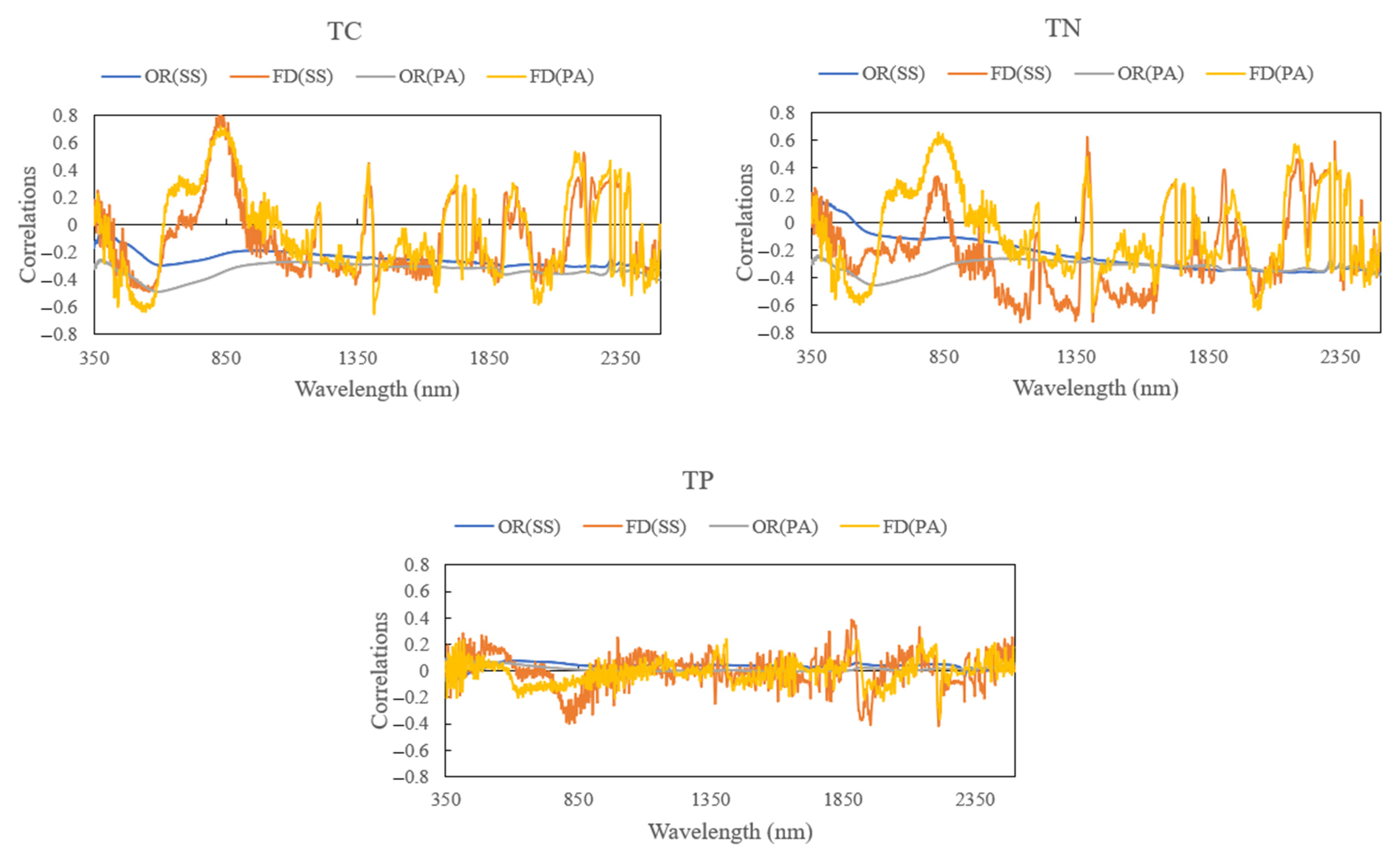
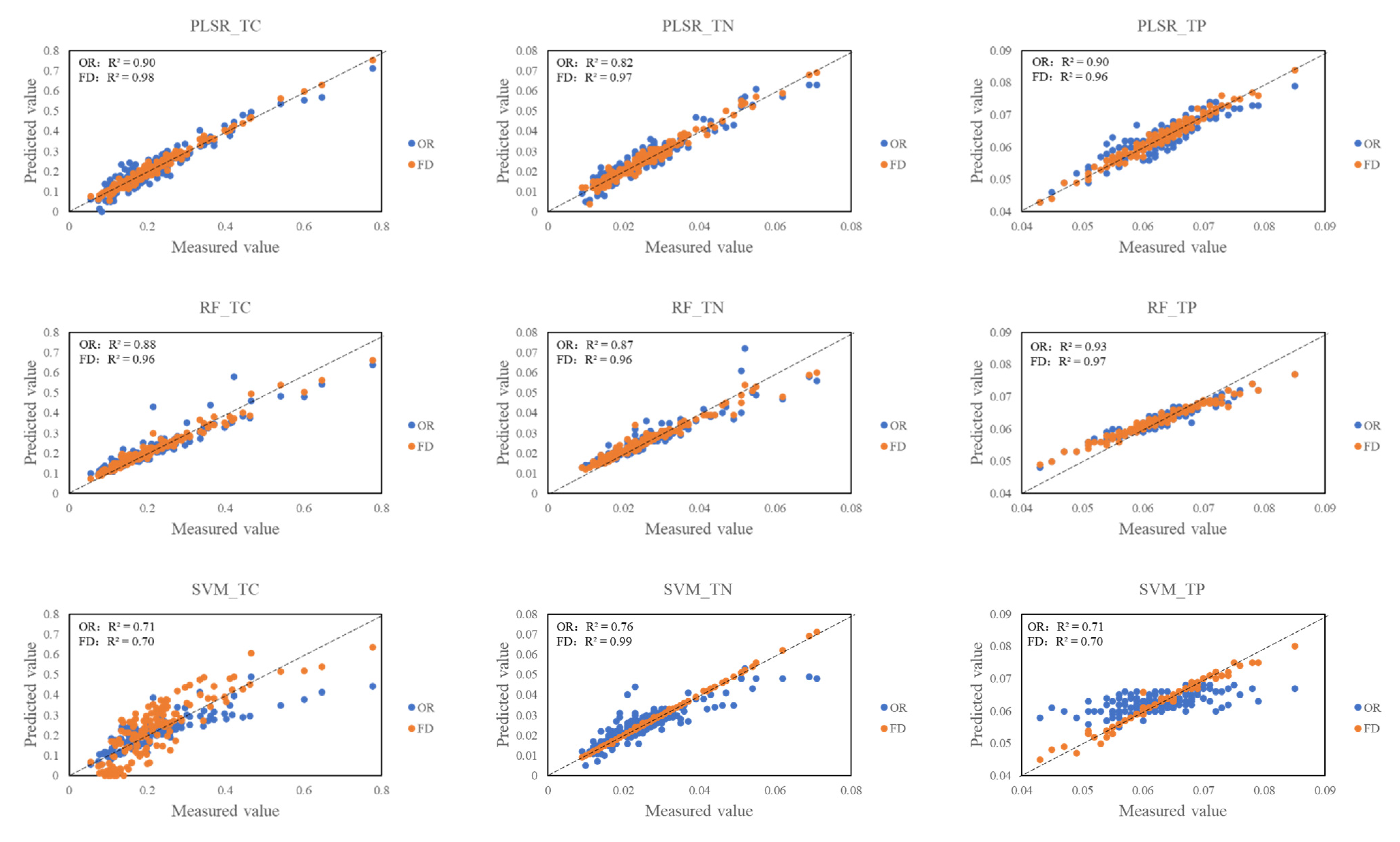

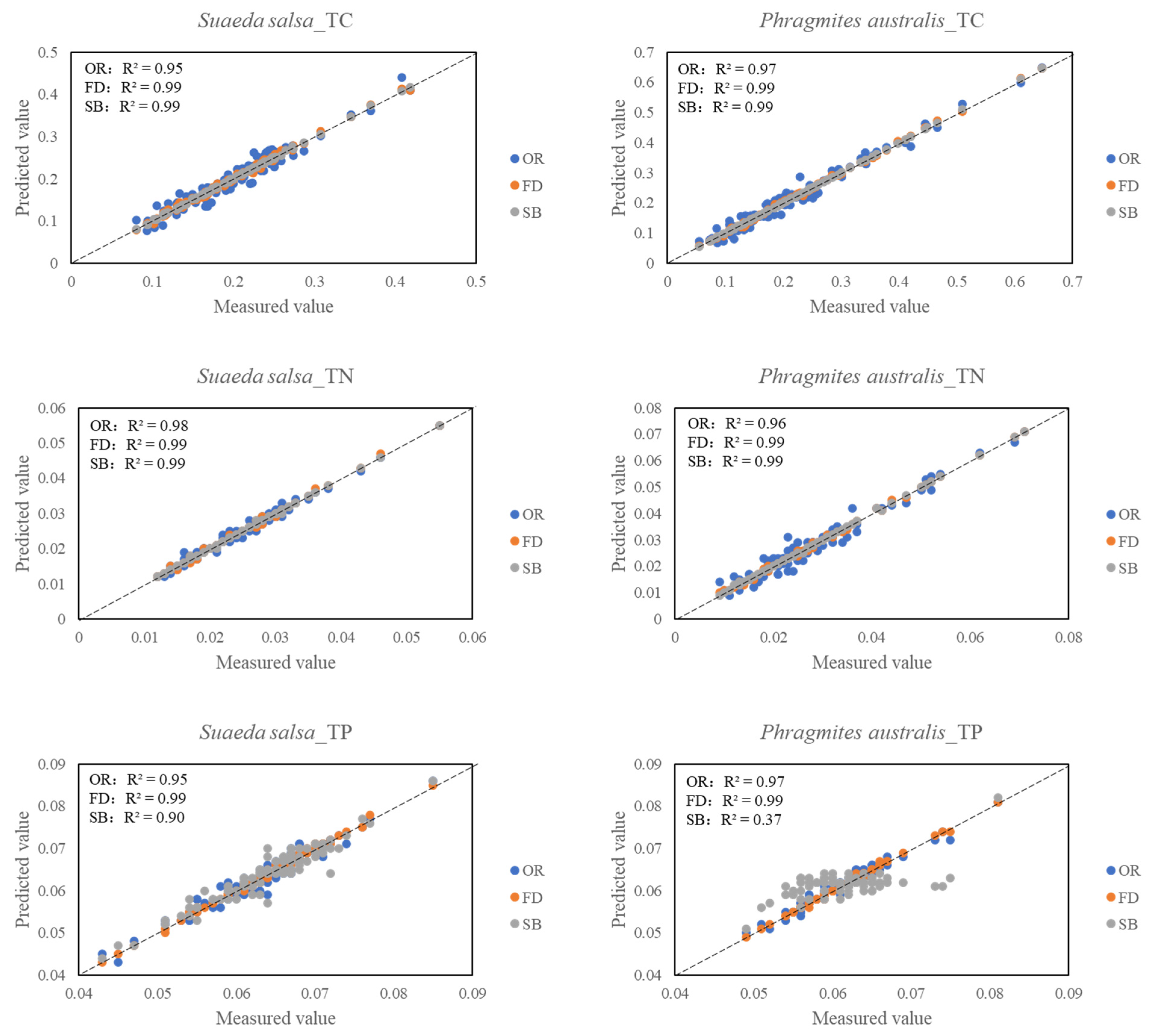

| Index | PLSR | RF | SVM | ||||||||||||||
|---|---|---|---|---|---|---|---|---|---|---|---|---|---|---|---|---|---|
| Model | Test | RPD | Model | Test | RPD | Model | Test | RPD | |||||||||
| R² | RMSE | R² | RMSE | R² | RMSE | R² | RMSE | R² | RMSE | R² | RMSE | ||||||
| TC | PA | OR | 0.97 | 0.020 | 0.79 | 0.078 | 2.11 | 0.94 | 0.051 | 0.87 | 0.054 | 2.69 | 0.85 | 0.094 | 0.77 | 0.074 | 1.37 |
| FD | 0.99 | 0.004 | 0.86 | 0.064 | 2.31 | 0.95 | 0.045 | 0.91 | 0.046 | 2.90 | 0.85 | 0.102 | 0.80 | 0.084 | 0.98 | ||
| SB | 0.99 | 0.001 | 0.89 | 0.052 | 2.95 | 0.96 | 0.042 | 0.92 | 0.043 | 3.19 | 0.83 | 0.098 | 0.79 | 0.083 | 1.09 | ||
| SS | OR | 0.95 | 0.016 | 0.57 | 0.060 | 1.46 | 0.84 | 0.053 | 0.67 | 0.047 | 1.56 | 0.82 | 0.099 | 0.79 | 0.039 | 1.78 | |
| FD | 0.99 | 0.015 | 0.62 | 0.056 | 1.58 | 0.96 | 0.023 | 0.81 | 0.037 | 1.93 | 0.87 | 0.024 | 0.85 | 0.033 | 2.37 | ||
| SB | 0.99 | 0.005 | 0.63 | 0.057 | 1.55 | 0.96 | 0.010 | 0.87 | 0.031 | 2.27 | 0.90 | 0.023 | 0.88 | 0.028 | 2.76 | ||
| MIX | OR | 0.90 | 0.035 | 0.67 | 0.119 | 1.12 | 0.88 | 0.050 | 0.73 | 0.109 | 0.91 | 0.71 | 0.089 | 0.64 | 0.104 | 0.76 | |
| FD | 0.98 | 0.002 | 0.65 | 0.122 | 1.04 | 0.96 | 0.027 | 0.86 | 0.092 | 0.97 | 0.70 | 0.096 | 0.61 | 0.113 | 1.37 | ||
| TN | PA | OR | 0.96 | 0.003 | 0.58 | 0.008 | 1.99 | 0.90 | 0.006 | 0.85 | 0.006 | 2.26 | 0.71 | 0.012 | 0.61 | 0.011 | 0.82 |
| FD | 0.99 | 0.001 | 0.76 | 0.008 | 1.88 | 0.94 | 0.005 | 0.92 | 0.005 | 2.92 | 0.82 | 0.011 | 0.68 | 0.010 | 1.04 | ||
| SB | 0.99 | 0.001 | 0.87 | 0.006 | 2.74 | 0.95 | 0.004 | 0.94 | 0.004 | 3.43 | 0.75 | 0.011 | 0.64 | 0.010 | 0.91 | ||
| SS | OR | 0.98 | 0.001 | 0.47 | 0.006 | 1.40 | 0.94 | 0.003 | 0.64 | 0.005 | 1.23 | 0.76 | 0.004 | 0.71 | 0.004 | 1.22 | |
| FD | 0.99 | 0.001 | 0.62 | 0.005 | 1.34 | 0.97 | 0.001 | 0.76 | 0.004 | 1.80 | 0.78 | 0.002 | 0.73 | 0.004 | 1.58 | ||
| SB | 0.99 | 0.001 | 0.66 | 0.005 | 1.46 | 0.96 | 0.001 | 0.78 | 0.004 | 1.85 | 0.80 | 0.002 | 0.76 | 0.004 | 1.68 | ||
| MIX | OR | 0.82 | 0.003 | 0.71 | 0.010 | 1.36 | 0.87 | 0.005 | 0.48 | 0.012 | 0.74 | 0.76 | 0.008 | 0.72 | 0.010 | 1.29 | |
| FD | 0.97 | 0.001 | 0.64 | 0.011 | 3.33 | 0.96 | 0.002 | 0.70 | 0.009 | 1.03 | 0.99 | 0.004 | 0.78 | 0.008 | 1.36 | ||
| TP | PA | OR | 0.97 | 0.001 | 0.52 | 0.004 | 1.41 | 0.93 | 0.002 | 0.62 | 0.003 | 1.33 | 0.49 | 0.004 | 0.44 | 0.004 | 1.10 |
| FD | 0.99 | 0.001 | 0.60 | 0.004 | 1.49 | 0.97 | 0.002 | 0.70 | 0.003 | 1.18 | 0.57 | 0.004 | 0.50 | 0.004 | 1.17 | ||
| SB | 0.37 | 0.004 | 0.29 | 0.005 | 0.75 | 0.92 | 0.002 | 0.76 | 0.003 | 1.73 | 0.63 | 0.003 | 0.53 | 0.004 | 1.20 | ||
| SS | OR | 0.95 | 0.002 | 0.45 | 0.006 | 1.18 | 0.94 | 0.003 | 0.52 | 0.005 | 1.00 | 0.59 | 0.005 | 0.52 | 0.005 | 1.19 | |
| FD | 0.99 | 0.001 | 0.53 | 0.005 | 1.21 | 0.96 | 0.001 | 0.64 | 0.004 | 1.34 | 0.64 | 0.003 | 0.61 | 0.004 | 1.11 | ||
| SB | 0.90 | 0.002 | 0.69 | 0.004 | 1.74 | 0.94 | 0.001 | 0.73 | 0.004 | 1.81 | 0.78 | 0.003 | 0.74 | 0.004 | 1.95 | ||
| MIX | OR | 0.90 | 0.002 | 0.47 | 0.007 | 1.00 | 0.93 | 0.002 | 0.40 | 0.006 | 0.47 | 0.71 | 0.002 | 0.39 | 0.005 | 0.48 | |
| FD | 0.96 | 0.001 | 0.49 | 0.006 | 0.93 | 0.97 | 0.001 | 0.31 | 0.006 | 0.30 | 0.70 | 0.002 | 0.33 | 0.006 | 0.72 | ||
| Element | Accuracy | Spectral Data | Model | Author | Accuracy in the Present Study |
|---|---|---|---|---|---|
| C | R2 = 0.95 | First derivative | RF | Wang S. et al., 2022 [52] | R2 = 0.91 |
| C | R2 = 0.44 | Untransformed | PLSR | Mondal B. P. et al., 2019 [53] | R2 = 0.67 |
| C | R2 = 0.81 | Smoothed reflectance | PLSR | Ribeiro S. G. et al., 2021 [49] | R2 = 0.89 |
| C | RPD = 2.52 | Untransformed | PLSR | Anna P. et al., 2020 [54] | RPD = 2.11 |
| N | R2 = 0.76 | Untransformed | RF | Lin X. L. et al., 2022 [55] | R2 = 0.85 |
| N | R2 = 0.35 | Untransformed | PLSR | Pechanec V. et al., 2021 [56] | R2 = 0.71 |
| N | R2 = 0.94 | Untransformed | SVM | Xu S. X. et al., 2021 [23] | R2 = 0.72 |
| N | R2 = 0.81 | Smoothed reflectance | PLSR | Li H. Y. et al., 2019 [57] | R2 = 0.87 |
| P | R2 = 0.34 | Untransformed | PLSR | Malmir M. et al., 2019 [58] | R2 = 0.47 |
| P | R2 = 0.54 | Untransformed | PLSR | Lu P. et al., 2013 [59] | R2 = 0.47 |
Publisher’s Note: MDPI stays neutral with regard to jurisdictional claims in published maps and institutional affiliations. |
© 2022 by the authors. Licensee MDPI, Basel, Switzerland. This article is an open access article distributed under the terms and conditions of the Creative Commons Attribution (CC BY) license (https://creativecommons.org/licenses/by/4.0/).
Share and Cite
Nie, L.; Dou, Z.; Cui, L.; Tang, X.; Zhai, X.; Zhao, X.; Lei, Y.; Li, J.; Wang, J.; Li, W. Hyperspectral Inversion of Soil Carbon and Nutrient Contents in the Yellow River Delta Wetland. Diversity 2022, 14, 862. https://doi.org/10.3390/d14100862
Nie L, Dou Z, Cui L, Tang X, Zhai X, Zhao X, Lei Y, Li J, Wang J, Li W. Hyperspectral Inversion of Soil Carbon and Nutrient Contents in the Yellow River Delta Wetland. Diversity. 2022; 14(10):862. https://doi.org/10.3390/d14100862
Chicago/Turabian StyleNie, Leichao, Zhiguo Dou, Lijuan Cui, Xiying Tang, Xiajie Zhai, Xinsheng Zhao, Yinru Lei, Jing Li, Jinzhi Wang, and Wei Li. 2022. "Hyperspectral Inversion of Soil Carbon and Nutrient Contents in the Yellow River Delta Wetland" Diversity 14, no. 10: 862. https://doi.org/10.3390/d14100862
APA StyleNie, L., Dou, Z., Cui, L., Tang, X., Zhai, X., Zhao, X., Lei, Y., Li, J., Wang, J., & Li, W. (2022). Hyperspectral Inversion of Soil Carbon and Nutrient Contents in the Yellow River Delta Wetland. Diversity, 14(10), 862. https://doi.org/10.3390/d14100862






